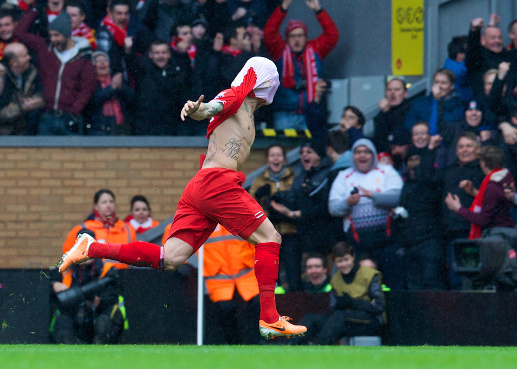Football management is a never ending jigsaw puzzle. Occasionally, a few pieces can be put together in succession, but you always get more parts to the ever-changing puzzle. Amongst the difficult pieces of the management conundrum left for Liverpool’s new messiah (or the normal one if he’d have you believe) to solve is our nightmarish set-piece taking. Despite an assist for James Milner in Liverpool’s last match, for many the sight of a red shirt approaching the corner flag has become wholly unbearable. Whoscored’s impressive situational statistics certainly does the club no favours, with Liverpool ranked joint last but-one from the foot of the table for success from set-pieces this season. Indeed, an array of short corner routines put in use to make up for Liverpool’s lack of a set-piece specialist has become symptomatic of the side’s failure to capitalize from an array of aerial talent.
A quick glance at the team sheet would leave many in disbelief as to the sheer abundance of talent wasted in this area of the game. For one, Martin Skrtel was the league’s top scoring defender in the 2013-14 season with 7 goals, while Christian Benteke and Sakho have an obvious proficiency with their strength and height. Additionally, the likes of Emre Can, Dejan Lovren and Jordan Henderson are hardly incapable of scoring goals via crosses from free-kicks or corners. Undeniably, Liverpool’s aerial prowess has apparently been squandered in place of Brendan Rodgers’ possession football – at least in the latter half of his tenure at the club.
Perhaps why fans expect so much from these goal scoring opportunities is largely due to Liverpool’s incredible success from set-pieces during the fateful 2013-14 season, as coached by Rodgers’ himself. Two years ago we were dominant in this area grabbing 36 goals from dead-ball situations, placing us top of the field with 10 more goals than nearest rivals Manchester City and 16 more than third place Everton. With Liverpool scoring from a remarkable 12 corners and 7 crossed free-kicks plus a variety of other set-piece goals, the team averaged just under a goal a game from dead-ball chances. And, in this time Liverpool weren’t just grabbing ‘cheap’ goals they were extracting the most they could from a strong squad.
Cut to 2015 and Liverpool failed to score a single goal from 34 corners in their first 6 games. Moreover, the few goals attributed to Liverpool from set-pieces includes an offside goal worked from a corner that was cleared. Regrettably, a 5.4% conversion rate from 2013/14 was clearly a ‘freak’ or rather fortunate statistic that would ultimately only lead to decline, and accordingly in 2014/15 Liverpool scored just 3 goals from 198 corners (amounting to a conversion rate of just 1.52% including an unfortunate Jonjo Shelvey own goal).
Some statisticians and ‘soccernomics’ fans are likely to retort that a reasonable conversion rate for corners is surprisingly close to 0. Yet, this appears largely erroneous when taking into account the sheer number of chances Liverpool once created from such opportunities. The consistent ability to exploit this area of the game has evidently suffered a drastic decline; largely due to an inability to replace Luis Suarez or Steven Gerrard’s set-piece skill; and a resultant failure or disregard to coach corner tactics, that has certainly lost points on the board.
Largely, Liverpool appear to ‘float’ the ball in from crossing positions, rather than opting for a direct, pacey delivery. And, with opposition goalkeepers able to come out and claim the ball uncontested from the 12-yard spot, Liverpool’s overcomplicated runs, flick-ons and dummies have created more confusion than creation. Elsewhere, direct free kicks have been few and far between, with Liverpool demonstrating the propensity to give away free-kicks in dangerous areas rather than win them. Certainly, the capacity for Liverpool to win free-kicks in threatening positions is far from what it was two seasons ago with Suarez’ jinking and zig-zagging runs consigned only to a distant memory.
Even so, this season and the last has categorically been defined by sighs of disappointment where the referee’s foam has usually been proceeded with a goal-kick. James Milner’s plainly awful attempt against Bournemouth has made many wake up in a cold sweat at night; with the midfielder stealing a chance from an inflated Christian Benteke, resulting in a wayward effort indicative of the failure of Liverpool’s ability to convert or come close to securing goals from set-pieces.
Jurgen Klopp’s coaching staff, and his own individual ability to turn around Liverpool’s competence from set-pieces will perhaps be an overlooked facet of the team’s chance creation. Yet, thanks to some enlightening stats from tactical analyst Mihail Vladimirov that when Klopp took charge of Dortmund he was keen to prioritise creating and scoring from dead-ball situations. Despite a poor final season, Klopp’s Dortmund finished 2nd, 4th and 1st in the league from goals created by set-pieces between the 2011/13 and 2013/14 seasons. Notably Klopp’s penultimate season saw an incredible 24 goals from set-pieces, a 33.3% improvement from the 16 goals created in his first season at the club. This track record of impressive statistics from set-pieces may indicate Klopp’s trump card, as if Liverpool are to emulate the aerial success of 2013/14 a vital supply of goals will be added to the currently dismal tally.
After an impressive start, the season-ending injury to Danny Ings will unfortunately emphasise the need for goals from players that are not traditionally strikers. This coupled with the likelihood of Daniel Sturridge getting injured at any single moment futhers the need for more unconventional goal methods to be focused on. And, although Klopp will be likely to prioritise free-flowing attacking football and the somewhat pretentious ‘gengenpressing’, facilitating an improvement in Liverpool’s set-piece taking could represent an opportunity to edge games, turn defeat into draws and draws into victories. With the top four race becoming ever more congested or disrupted thanks to the surprise triumphs of teams like Leicester City and Crystal Palace, success in the league will be determined by the narrowest of margins, and perhaps by some of the more surprising parts of the management puzzle. Ultimately, Liverpool’s challenge will rest on such micro-factors, and so Klopp and his management team must engineer improvement from dead-ball situations, lest our challenge for the Champions League be left dead in the water.
Ben Butler
Latest posts by Ben Butler (see all)
- The risk of Klopp’s transfer waiting game - September 2, 2016
- Have Liverpool done enough in the transfer market? - August 20, 2016
- What can we take away from Liverpool’s win against Tranmere? - July 8, 2016

